A Method for Modeling Urban Water Infrastructures Combining Geo-Referenced Data
Abstract
:1. Introduction
2. State-of-the-Art
2.1. Spatial Disaggregation of Water Demand
2.2. Generation of Water Distribution Systems
2.3. Resilience of Water Distribution Systems
3. Framework
4. Data and Methods
4.1. Data
4.2. Disaggregation of Water Demand
4.3. Identification of the Possible Water Network
4.4. Water Distribution System Design Optimization Problem
4.5. Optimization Instance
5. Results and Discussion
Limitations
6. Conclusions and Outlook
Author Contributions
Funding
Institutional Review Board Statement
Informed Consent Statement
Data Availability Statement
Acknowledgments
Conflicts of Interest
Abbreviations
| MDPI | Multidisciplinary Digital Publishing Institute |
| DOAJ | Directory of open access journals |
| TLA | Three letter acronym |
| LD | Linear dichroism |
| LCZ | Local Climate Zones |
| WDS | water distribution system |
References
- Louis, H. Sullivan. The tall office building artistically considered. West. Archit. 1922, 1922, 3–11. [Google Scholar]
- Rams, D.; Klatt, J. Weniger, Aber Besser: Skizze für Phonokombination TP 1 = Less but Better: Drawing for Phono Combination TP 1; Jo Klatt Design und Design Verlag: Hamburg, Germany, 1995. [Google Scholar]
- Pelz, P.F.; Groche, P.; Pfetsch, M.E.; Schäffner, M. Mastering Uncertainty in Mechanical Engineering; Springer Tracts in Mechanical Engineering; Springer International Publishing: Berlin/Heidelberg, Germany, 2021. [Google Scholar]
- Bao, K.; Padsala, R.; Thrän, D.; Schröter, B. Urban Water Demand Simulation in Residential and Non-Residential Buildings Based on a CityGML Data Model. ISPRS Int. J. Geo-Inf. 2020, 9, 642. [Google Scholar] [CrossRef]
- Sitzenfrei, R.; Fach, S.; Kleidorfer, M.; Urich, C.; Rauch, W. Dynamic virtual infrastructure benchmarking: DynaVIBe. Water Supply 2010, 10, 600–609. [Google Scholar] [CrossRef]
- Shin, S.; Lee, S.; Judi, D.; Parvania, M.; Goharian, E.; McPherson, T.; Burian, S. A Systematic Review of Quantitative Resilience Measures for Water Infrastructure Systems. Water 2018, 10, 164. [Google Scholar] [CrossRef] [Green Version]
- Pesantez, J.E.; Berglund, E.Z.; Kaza, N. Smart meters data for modeling and forecasting water demand at the user-level. Environ. Model. Softw. 2020, 125, 104633. [Google Scholar] [CrossRef]
- Zubaidi, S.; Al-Bugharbee, H.; Ortega-Martorell, S.; Gharghan, S.; Olier, I.; Hashim, K.; Al-Bdairi, N.; Kot, P. A Novel Methodology for Prediction Urban Water Demand by Wavelet Denoising and Adaptive Neuro-Fuzzy Inference System Approach. Water 2020, 12, 1628. [Google Scholar] [CrossRef]
- Zubaidi, S.L.; Ortega-Martorell, S.; Al-Bugharbee, H.; Olier, I.; Hashim, K.S.; Gharghan, S.K.; Kot, P.; Al-Khaddar, R. Urban Water Demand Prediction for a City That Suffers from Climate Change and Population Growth: Gauteng Province Case Study. Water 2020, 12, 1885. [Google Scholar] [CrossRef]
- Viola, F.; Caracciolo, D.; Deidda, R. Modelling the mutual interactions between hydrology, society and water supply systems. Hydrol. Sci. J. 2021, 66, 1265–1274. [Google Scholar] [CrossRef]
- Demuzere, M.; Hankey, S.; Mills, G.; Zhang, W.; Lu, T.; Bechtel, B. Combining expert and crowd-sourced training data to map urban form and functions for the continental US. Sci. Data 2020, 7, 264. [Google Scholar] [CrossRef]
- Pastor-Jabaloyes, L.; Arregui, F.; Cobacho, R. Water End Use Disaggregation Based on Soft Computing Techniques. Water 2018, 10, 46. [Google Scholar] [CrossRef] [Green Version]
- Stewart, I.D.; Oke, T.R. Local Climate Zones for Urban Temperature Studies. Bull. Am. Meteorol. Soc. 2012, 93, 1879–1900. [Google Scholar] [CrossRef]
- Demuzere, M.; Bechtel, B.; Middel, A.; Mills, G. Mapping Europe into local climate zones. PLoS ONE 2019, 14, e0214474. [Google Scholar] [CrossRef] [Green Version]
- Taubenböck, H.; Debray, H.; Qiu, C.; Schmitt, M.; Wang, Y.; Zhu, X.X. Seven city types representing morphologic configurations of cities across the globe. Cities 2020, 105, 102814. [Google Scholar] [CrossRef]
- Hu, J.; Wang, Y.; Taubenböck, H.; Zhu, X.X. Land consumption in cities: A comparative study across the globe. Cities 2021, 113, 103163. [Google Scholar] [CrossRef]
- Mair, M.; Zischg, J.; Rauch, W.; Sitzenfrei, R. Where to Find Water Pipes and Sewers?—On the Correlation of Infrastructure Networks in the Urban Environment. Water 2017, 9, 146. [Google Scholar] [CrossRef] [Green Version]
- DIN-Normausschuss Bauwesen. DIN 1998-Placement of Service Conduits in Public Circulation Areas—Guideline for Planning; German Standardisation Agency: Berlin, Germany, 2018. [Google Scholar]
- Planet Dump. 2015. Available online: https://planet.openstreetmap.org/ (accessed on 18 June 2021).
- Google. Satellite Images of Cologne. Available online: https://www.google.de/maps/@50.93517027036617,6.9501295729336405z (accessed on 14 June 2021).
- Jarvis, A.; Reuter, H.I.; Nelson, A.; Guevara, E. Hole-Filled Seamless SRTM Data V4; CIAT: Rome, Italy, 2008. [Google Scholar]
- Sitzenfrei, R.; Möderl, M.; Rauch, W. Automatic generation of water distribution systems based on GIS data. Environ. Model. Softw. Environ. Data News 2013, 47, 138–147. [Google Scholar] [CrossRef] [Green Version]
- Müller, T.M.; Leise, P.; Lorenz, I.S.; Altherr, L.C.; Pelz, P.F. Optimization and validation of pumping system design and operation for water supply in high-rise buildings. Optim. Eng. 2021, 22, 643–686. [Google Scholar] [CrossRef]
- Lorenz, I.S.; Pelz, P. Optimal Resilience Enhancement of Water Distribution Systems. Water 2020, 12, 2602. [Google Scholar] [CrossRef]
- Schänzle, C.; Altherr, L.C.; Ederer, T.; Lorenz, U.; Pelz, P.F. As Good As It Can Be-Ventilation System Design By A Combined Scaling And Discrete Optimization Method. In Proceedings of the International Conference on Fan Noise, Fan Technology and Numerical Methods (Fan 2015), Lyon, France, 15–17 April 2015. [Google Scholar]
- Pelz, P.F.; Lorenz, U.; Ludwig, G. Besser geht’s nicht. TOR plant das energetisch optimale Fluidsystem. Chem. More 2014, 6, 2–9. [Google Scholar]
- Ugarelli, R.; Venkatesh, G.; Brattebø, H.; Di Federico, V.; Sægrov, S. Asset Management for Urban Wastewater Pipeline Networks. J. Infrastruct. Syst. 2010, 16, 112–121. [Google Scholar] [CrossRef]
- Altherr, L.C.; Brötz, N.; Dietrich, I.; Gally, T.; Geßner, F.; Kloberdanz, H.; Leise, P.; Pelz, P.F.; Schlemmer, P.D.; Schmitt, A. Resilience in Mechanical Engineering—A Concept for Controlling Uncertainty during Design, Production and Usage Phase of Load-Carrying Structures. Appl. Mech. Mater. 2018, 885, 187–198. [Google Scholar] [CrossRef] [Green Version]
- Yazdani, A.; Otoo, R.A.; Jeffrey, P. Resilience enhancing expansion strategies for water distribution systems: A network theory approach. Environ. Model. Softw. 2011, 26, 1574–1582. [Google Scholar] [CrossRef]
- Herrera, M.; Abraham, E.; Stoianov, I. A Graph-Theoretic Framework for Assessing the Resilience of Sectorised Water Distribution Networks. Water Resour. Manag. 2016, 30, 1685–1699. [Google Scholar] [CrossRef] [Green Version]
- Lorenz, I.S.; Altherr, L.C.; Pelz, P.F. Resilience Enhancement of Critical Infrastructure—Graph Theoretical Resilience Analysis of the Water Distribution System in the German City of Darmstadt. In 14th WCEAM Proceedings; Crespo Márquez, A., Komljenovic, D., Amadi-Echendu, J., Eds.; Lecture Notes in Mechanical Engineering; Springer International Publishing: Cham, Switzerland, 2021; pp. 137–149. [Google Scholar] [CrossRef]
- Altherr, L.C.; Joggerst, L.; Leise, P.; Pfetsch, M.E.; Schmitt, A.; Wendt, J. On Obligations in the Development Process of Resilient Systems with Algorithmic Design Methods. Appl. Mech. Mater. 2018, 885, 240–252. [Google Scholar] [CrossRef] [Green Version]
- Todini, E. Looped water distribution networks design using a resilience index based heuristic approach. Urban Water 2000, 2, 115–122. [Google Scholar] [CrossRef]
- Hollnagel, E. Epilogue: RAG—The resilience analysis grid. In Resilience Engineering in Practice. A Guidebook; Hollnagel, E., Pariès, J., Woods, D.D., Wreathall, J., Eds.; Ashgate Publishing, Ltd.: Farnham, UK, 2011; pp. 275–296. [Google Scholar]
- Hollnagel, E. Prologue: The scope of resilience engineering. In Resilience Engineering in Practice. A Guidebook; Hollnagel, E., Pariès, J., Woods, D.D., Wreathall, J., Eds.; Ashgate Publishing, Ltd.: Farnham, UK, 2011. [Google Scholar]
- Hollnagel, E. FRAM, The Functional Resonance Analysis Method. Modelling Complex Socio-Technical Systems; CRC Press: Boca Raton, FL, USA, 2012. [Google Scholar]
- Bruneau, M.; Chang, S.E.; Eguchi, R.T.; Lee, G.C.; O’Rourke, T.D.; Reinhorn, A.M.; Shinozuka, M.; Tierney, K.; Wallace, W.A.; von Winterfeldt, D. A Framework to Quantitatively Assess and Enhance the Seismic Resilience of Communities. Earthq. Spectra 2003, 19, 733–752. [Google Scholar] [CrossRef] [Green Version]
- Hashimoto, T.; Stedinger, J.R.; Loucks, D.P. Reliability, resiliency, and vulnerability criteria for water resource system performance evaluation. Water Resour. Res. 1982, 18, 14–20. [Google Scholar] [CrossRef] [Green Version]
- Qiu, C.; Schmitt, M.; Zhu, X.X. Fusing Multi-Seasonal Sentinel-2 Images with Residual Convolutional Neural Networks for Local Climate Zone-Derived Urban Land Cover Classification. In Proceedings of the IGARSS 2019—2019 IEEE International Geoscience and Remote Sensing Symposium, Yokohama, Japan, 28 July–2 August 2019; IEEE: Piscataway, NJ, USA, 2019; Volume 72019, pp. 5037–5040. [Google Scholar] [CrossRef] [Green Version]
- QGIS Association. 2021. Available online: https://www.qgis.org/en/site/index.html (accessed on 12 June 2021).
- Hart, W.E. Pyomo-Optimization Modeling in Python, 2nd ed.; Springer Optimization and Its Applications; Springer: Cham, Switzerland, 2017; Volume 67. [Google Scholar]
- Hagberg, A.A.; Schult, D.A.; Swart, P.J. Exploring Network Structure, Dynamics, and Function using NetworkX. In Proceedings of the 7th Python in Science Conference, Pasadena, CA, USA, 19–24 August 2008; Varoquaux, G., Vaught, T., Millman, J., Eds.; pp. 11–15. [Google Scholar]
- Varoquaux, G.; Vaught, T.; Millman, J. (Eds.) In Proceedings of the 7th Python in Science Conference, SciPy, Pasadena, CA, USA, 19–24 August 2008. Available online: https://hal.inria.fr/hal-00502586/en (accessed on 19 August 2021).
- DIN Deutsches Institut für Normung e.V. DIN 1988–Technische Regeln für Trinkwasser-Installationen – Teil 200: Installation Typ A (geschlossenes System)–Planung, Bauteile, Apparate, Werkstoffe; Technische Regel des DVGW German Standardisation Agency: Berlin, Germany, 2012. [Google Scholar]
- Chee, R.; Lansey, K.; Chee, E. Estimation of Water Pipe Installation Construction Costs. J. Pipeline Syst. Eng. Pract. 2018, 9. [Google Scholar] [CrossRef]
- Nussbaum, T.; Thalmann, S. Dimensionierung von Fernwärmenetzen: Minimale Rohrdurchmesser Reduzieren Kosten und Netzverluste; VDI Verlag GmbH: Düsseldorf, Germany, 2017; Available online: www.ingenieur.de (accessed on 14 June 2021).
- Lorenz, I.S.; Pouls, K.; Pelz, P.F. Comparability of Water Infrastructure Resilience of Different Urban Structures. In ICUME; Springer: Cham, Switzerland, 2020. [Google Scholar]
- Meirelles, G.; Brentan, B.; Izquierdo, J.; Ramos, H.; Luvizotto, E. Trunk Network Rehabilitation for Resilience Improvement and Energy Recovery in Water Distribution Networks. Water 2018, 10, 693. [Google Scholar] [CrossRef] [Green Version]
- Tatem, A.J. WorldPop, open data for spatial demography. Sci. Data 2017, 4, 170004. [Google Scholar] [CrossRef]
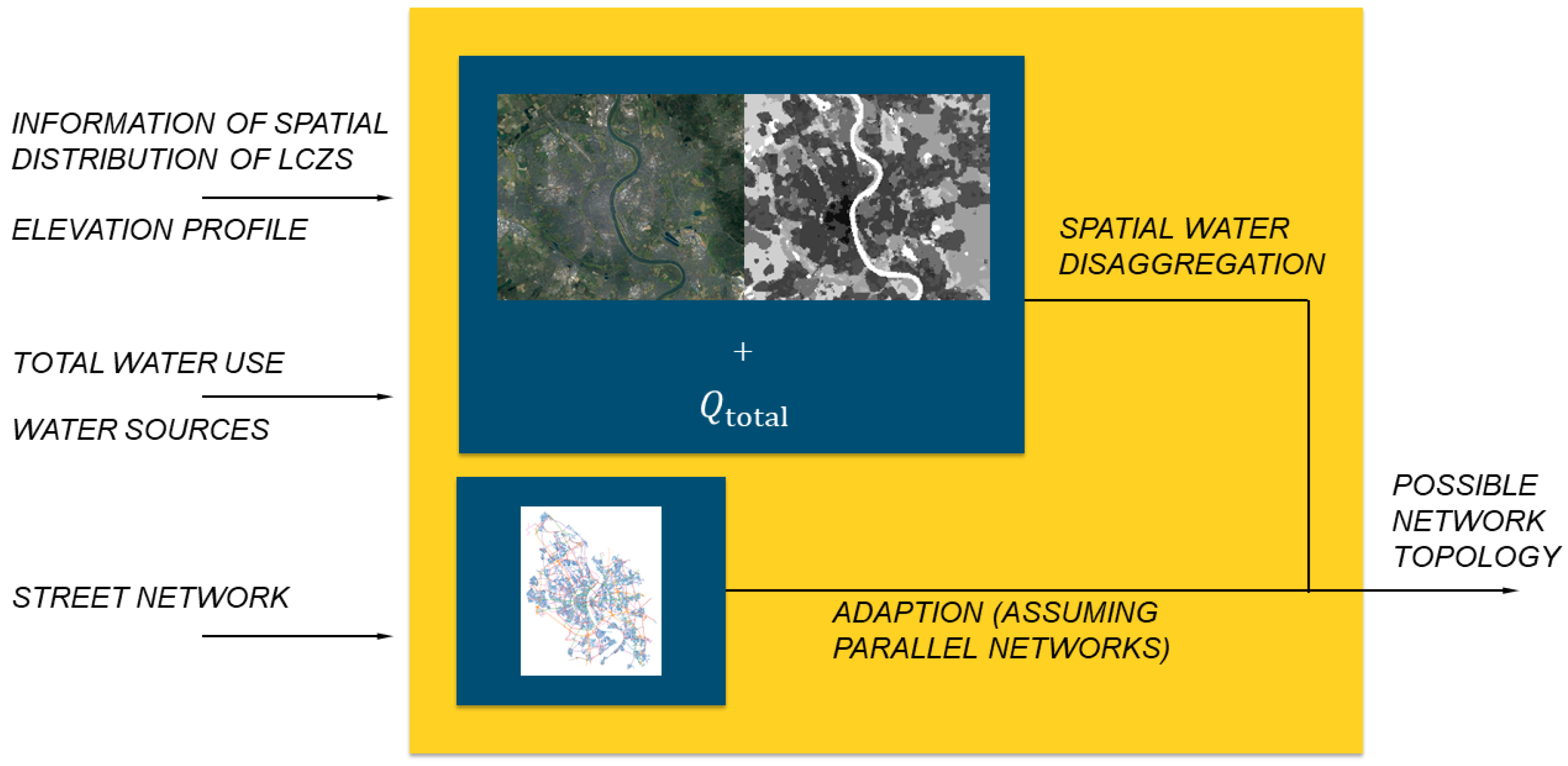
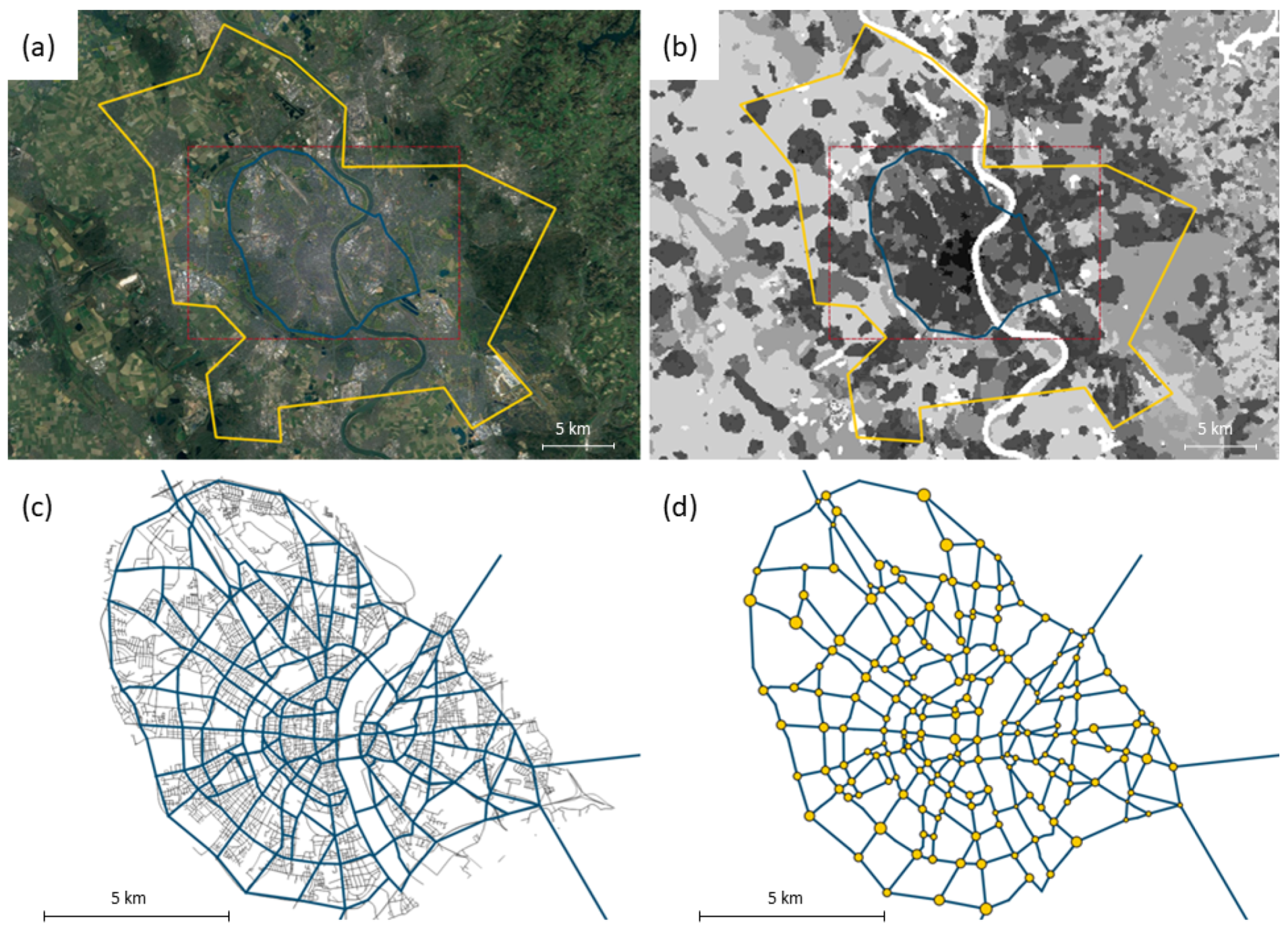
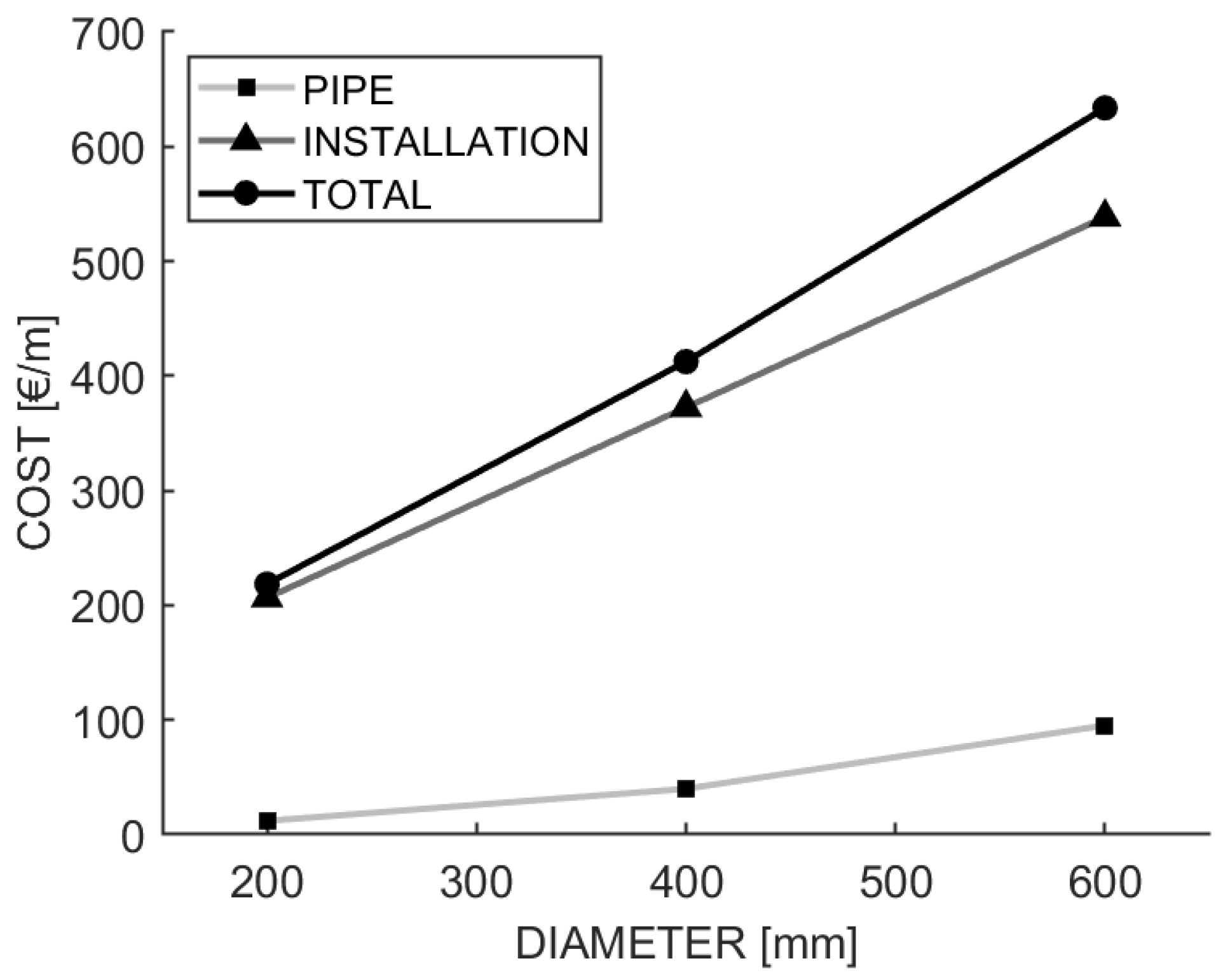
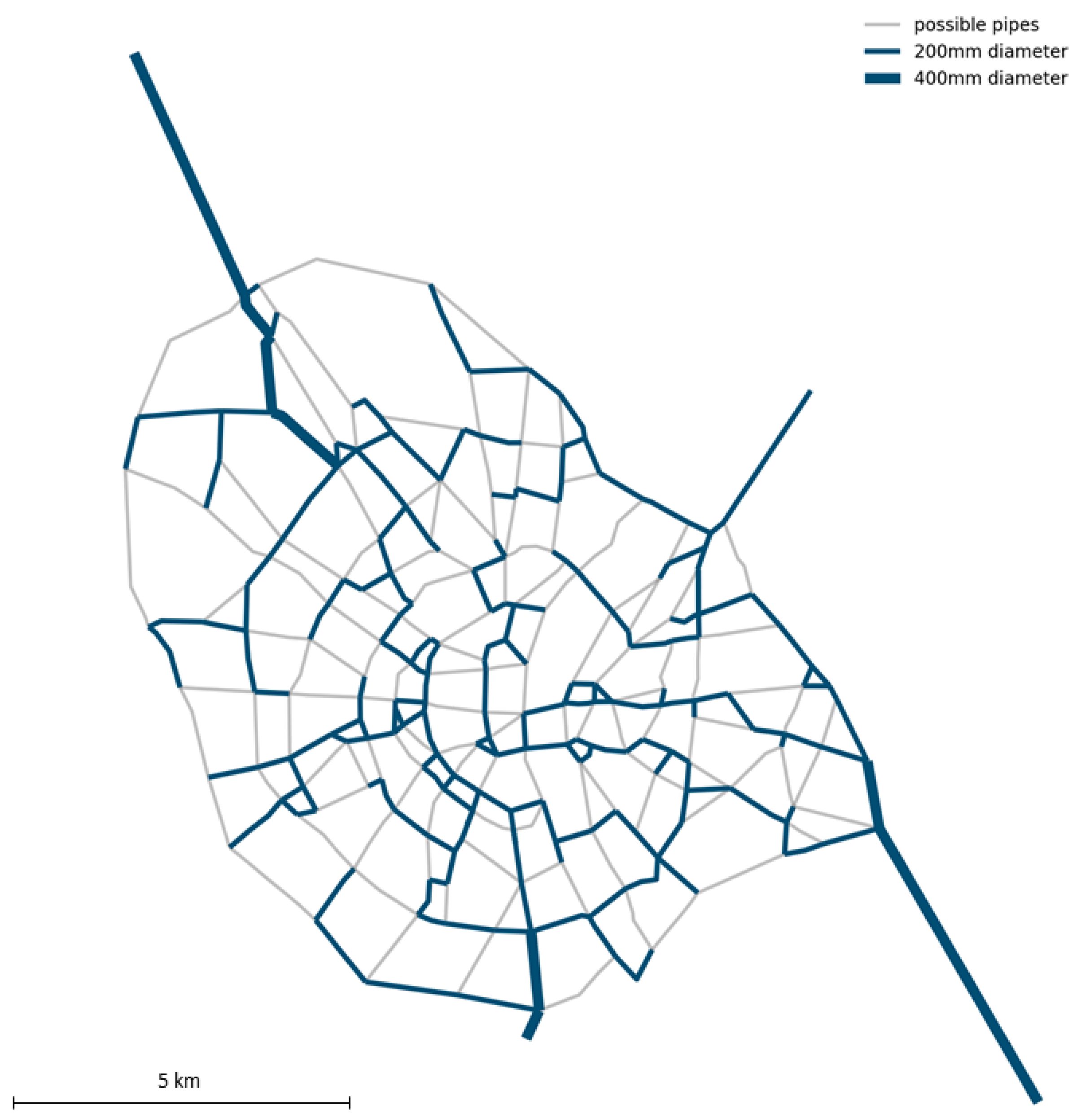
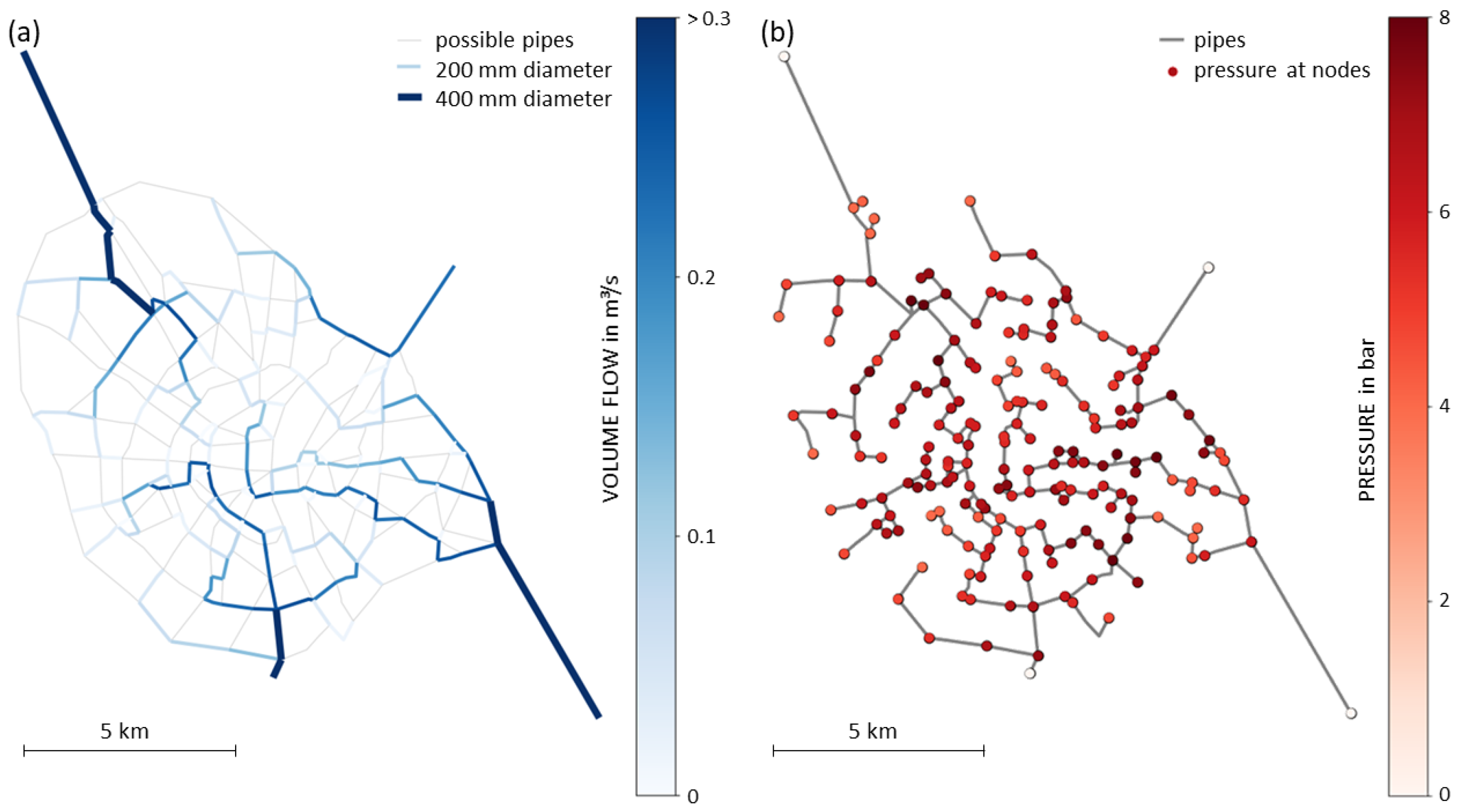
| LCZ | Description | Built-Up Surface Fraction in % | Height in m | Average Surface Fraction in % | Average Height in m | Av. Volume per Area in m |
|---|---|---|---|---|---|---|
| 1 | Compact high-rise | 40–60 | >25 | 50 | 25 | 12.5 |
| 2 | Compact midrise | 40–70 | 10–25 | 55 | 17.5 | 9.625 |
| 3 | Compact low-rise | 20–40 | 3–10 | 30 | 6.5 | 1.95 |
| 4 | Open high-rise | 20–40 | >25 | 30 | 25 | 7.5 |
| 5 | Open midrise | 20–40 | 10–25 | 30 | 17.5 | 5.25 |
| 6 | Open low-rise | 60–90 | 3–10 | 75 | 6.5 | 4.875 |
| 7 | Lightweight low-rise | 30–50 | 2–4 | 40 | 3 | 1.2 |
| 8 | Large low-rise | 10–20 | 3–10 | 15 | 6.5 | 0.975 |
| 9 | Sparsely built | 20–30 | 3–10 | 25 | 6.5 | 1.625 |
| 10 | Heavy industry | 20–30 | 5–15 | - | - | 25 * |
| Set | Subset of | Description |
|---|---|---|
| Set of nodes. | ||
| Set of adjacent nodes . | ||
| Set of consumer nodes. | ||
| Set of reservoir nodes. | ||
| Root reservoir node to constrain one connected network. | ||
| Set of directed edges with start- and end-node (). | ||
| Set of available pipe diameters. |
| Variable | Domain | Description |
|---|---|---|
| Volume flow rate for each directed pipe. . | ||
| Source volume flow . | ||
| Pressure at each node . | ||
| Pressure loss . | ||
| Pressure increase due to pumps . | ||
| Decision variable for choosing the edges on which to place pipes and their diameters. , | ||
| Decision variable for choosing a path between all reservoirs to guarantee one connected network , . | ||
| Decision variable for choosing the pump locations . |
| Parameter | Domain | Description |
|---|---|---|
| Scalar parameters | ||
| Maximum volume flow rate | ||
| Minimum pressure at consumer nodes. | ||
| Minimum pressure increase for pumps. | ||
| Maximum pressure for big-M expression. | ||
| Maximum static pressure to protect pipes. | ||
| Mean velocity for pressure loss calculation. | ||
| G | Gravitational constant. | |
| Density of water. | ||
| Minimum average link density [29]. | ||
| Minimum average node degree [29]. | ||
| Minimum meshed-ness coefficient [29]. | ||
| Indexed Parameters | ||
| Maximum volume flow . | ||
| Water demand . | ||
| Maximum volume flow to limit maximum velocity . | ||
| Static pressure . | ||
| Elevation . | ||
| Pipe length . | ||
| Pipe diameter . | ||
| Pressure loss coefficient . | ||
| Installation cost for pipes . |
| Parameter | Instance | Description |
|---|---|---|
| Scalar parameters | Value | |
| 2.71 m3 s−1 | Maximum volume flow rate | |
| 4 bar | Minimum pressure at consumer nodes. | |
| 1 bar | Minimum pressure increase for pumps. | |
| 14.18 bar | Maximum pressure for big-M expression. | |
| 8 bar | Maximum static pressure to protect pipes. | |
| Mean velocity for pressure loss calculation. | ||
| G | 9.81 m s−2 | Gravitational constant. |
| 1000 kg m−3 | Density of water. | |
| 0.0008 | Minimum average link density [29]. | |
| 2 | Minimum average node degree [29]. | |
| 0.04 | Minimum meshed-ness coefficient [29]. | |
| Indexed Parameters | Range | |
| Maximum volume flow . | ||
| Water demand . | ||
| Maximum volume flow to limit maximum velocity . | ||
| Static pressure . | ||
| Elevation . | ||
| Pipe length . | ||
| Pipe diameter . | ||
| Pressure loss coefficient . | ||
| € | Installation cost for pipes . |
Publisher’s Note: MDPI stays neutral with regard to jurisdictional claims in published maps and institutional affiliations. |
© 2021 by the authors. Licensee MDPI, Basel, Switzerland. This article is an open access article distributed under the terms and conditions of the Creative Commons Attribution (CC BY) license (https://creativecommons.org/licenses/by/4.0/).
Share and Cite
Rehm, I.-S.; Friesen, J.; Pouls, K.; Busch, C.; Taubenböck, H.; Pelz, P.F. A Method for Modeling Urban Water Infrastructures Combining Geo-Referenced Data. Water 2021, 13, 2299. https://doi.org/10.3390/w13162299
Rehm I-S, Friesen J, Pouls K, Busch C, Taubenböck H, Pelz PF. A Method for Modeling Urban Water Infrastructures Combining Geo-Referenced Data. Water. 2021; 13(16):2299. https://doi.org/10.3390/w13162299
Chicago/Turabian StyleRehm, Imke-Sophie, John Friesen, Kevin Pouls, Christoph Busch, Hannes Taubenböck, and Peter F. Pelz. 2021. "A Method for Modeling Urban Water Infrastructures Combining Geo-Referenced Data" Water 13, no. 16: 2299. https://doi.org/10.3390/w13162299
APA StyleRehm, I.-S., Friesen, J., Pouls, K., Busch, C., Taubenböck, H., & Pelz, P. F. (2021). A Method for Modeling Urban Water Infrastructures Combining Geo-Referenced Data. Water, 13(16), 2299. https://doi.org/10.3390/w13162299






